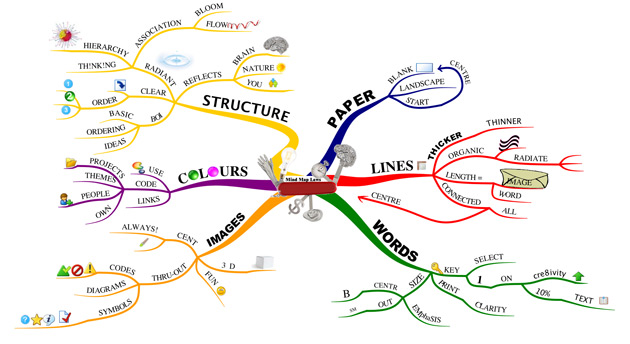WTT-02 – Mind Maps in Testing
 (Picture credit: “Mind Map Laws” – 7 Steps to Making a Mind Map by Tony Buzan, the inventor of mind mapping)
(Picture credit: “Mind Map Laws” – 7 Steps to Making a Mind Map by Tony Buzan, the inventor of mind mapping)
There is a strange confusion about electronic artifacts: they’re seen as a deliverable on and by itself. Process model document is confused with the working process. Intention documents (especially test plans) are given much more attention than the actual preparation and execution. Knowledge artifacts deemed more important than the actual knowledge within the heads.
Mind maps is a great example that highlights the controversy. I’ve been observing attention to mind maps in testing for nearly a decade. Variations aside, I can generalize these attempts into two categories.
Mind maps as end artifacts. Things don’t go great this way.
- Comprehensive mind maps are hard to create in one take.
- Mind maps may overwhelm with their complexity and that results in overall rejection.
- Mind maps don’t provide step by step walkthrough as other forms of documentation and presentation.
- Mind maps generally don’t have as much details as documents.
- Mind maps can be hard to print.
- Mind maps require skills and judgment to be put in use – they cannot be followed in scripted fashion as templates.
Mind maps as learning and information management helpers. Including note taking, brainstorming, analysis, decision-making, and context-switching. Those who use mind maps these ways find them absolutely awesome.
- Mind mapping, used in learning, becomes a highly structured, visual form of note taking. It becomes a rapid learning technique.
- Mind maps by their very own organization perfectly support structured analysis.
- Mind maps enable broad view, help exposing pro’s and con’s, and support more conscious, better balanced decisions.
- Large, comprehensive mind maps become an external memory of their creator, an outlet of the brain, dedicated to the particular project or problem that is no longer necessary to constantly keep in mind – without risk of losing the view – an invaluable option for people leading multiple streams and willing to switch between contexts with maximized efficiency.
To conclude, mind maps become really valuable for their authors and those who took time to follow the author’s thought, and built a connection to the mind map in their own mind. In this sense, mind maps are much like heuristics.
Like any heuristic, a mind map cannot be just handed over. And the skill of mind mapping is something more substantial than an ability to operate some mind mapping tool.
One particular challenge with complex skills is training and development: simpler aspects are easy to mimic, but it takes a lot of practice to put them all together.
Considering short timeframes of Weekend Testing, I take an asymmetric approach: instead of simplifying the skill, I simplify the context. The goal will be to provide initial exercise during the session that can be taken further through individual practice.
Come join Weekend Testing Toronto session this Saturday, February 21st, for practical mind mapping and discussion!


